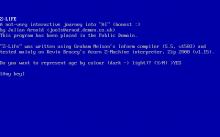
(This also frees up enough RAM that you can do the neighbor count mentioned above).

CONWAY GAME OF LIFE RTS SOFTWARE
Perhaps you could use 2x2 pixels per cell (so only 3,072 cells visible) or 3x3 pixels per cell (so only 1,376 cells visible), so your software does less work and so gives the illusion of running faster. It's often faster to store the neighbor counts, incrementing all 8 neighbors at birth and decrementing all 8 neighbors at death, rather than recalculating the number of neighbors from scratch every generation - but it doesn't look like you have enough memory for this approach. There are several bit-twiddling tricks to take a bitmap and calculate the number of neighbors of several cells in parallel on such a processor. If you can't even store 2 bits per cell, there's not a lot of room to do much. That's already over half of the 16,384 bits you say are "available". Game.of.life(side=150, steps=300, file="conway.Storing 1 bit per pixel of a 96x128 pixel display gives 12,288 bits. Write.gif(storage, filename, col="jet", delay=5) # writing the results into an animated gif Storage <- storage/max(storage) # scaling the results # - this is in order to make the animation prettier # note that I am storing the array of Ni values. # filename - name of the animated gif file # side - side of the game of life arena (matrix)
CONWAY GAME OF LIFE RTS INSTALL
Also, make sure to install the caTools library. Note that you may run out of memory if you specify a very large array.
CONWAY GAME OF LIFE RTS CODE
See the code below for how it is actually done. My solution only hides the iteration process by using the R-optimized form of matrix operations and logical subscripting. Also note that in reality the processor does actually iterate through all grid cells the solution presented here does not make all of the iterations happen at the same time. In MatLab you would do this by using the the shift function and so your code would be even simpler. In R this implementation works MUCH faster than any looping solution. In the next step you use logical subscripting to apply the rules of GoL (conditional on the array of Ni values) to the original array. Next, you stack all of the copies (“sum them up” using the + operator in R) and this will give you a new array of Ni values.ĥ. Then you do similar thing with copies 5-8 but now you shift these by 1 position diagonally. So you are essentially shifting the copies of the original array by 1 position to the left, right, up and down.ģ. – In copy 4 you delete the row at the bottom and add a row of zeroes to the very top. – In copy 3 you delete the uppermost row and add row of zeroes to the bottom.

– In copy 1 you delete the leftmost column and add column of zeroes to the very right. What you first need to do is to make 8 copies of the original array. However, iterating through all cells i would take ages in R.

Once you know Ni, you change the state of the focal cell i accordingly (to 0 or to 1 using the rules of GoL). You need to figure out what is the number Ni of living cells in the neighborhood of each focal cell i.Ģ. You have an rectangular array (matrix) of living (1) and dead (0) cells. He suggested to make GoL in R fast by taking the advantage of the somewhat optimized matrix operations. A couple of years ago my friend Martin Weiser came with an idea to avoid the individual iterations.

Cellular automata in R are usually painfully slow if you iterate through all grid cells in an array. Here I demonstrate a simple way to code Conway’s game of life (GoL) in R and to produce the animation above.


 0 kommentar(er)
0 kommentar(er)
